- News
- Reviews
- Bikes
- Accessories
- Accessories - misc
- Computer mounts
- Bags
- Bar ends
- Bike bags & cases
- Bottle cages
- Bottles
- Cameras
- Car racks
- Child seats
- Computers
- Glasses
- GPS units
- Helmets
- Lights - front
- Lights - rear
- Lights - sets
- Locks
- Mirrors
- Mudguards
- Racks
- Pumps & CO2 inflators
- Puncture kits
- Reflectives
- Smart watches
- Stands and racks
- Trailers
- Clothing
- Components
- Bar tape & grips
- Bottom brackets
- Brake & gear cables
- Brake & STI levers
- Brake pads & spares
- Brakes
- Cassettes & freewheels
- Chains
- Chainsets & chainrings
- Derailleurs - front
- Derailleurs - rear
- Forks
- Gear levers & shifters
- Groupsets
- Handlebars & extensions
- Headsets
- Hubs
- Inner tubes
- Pedals
- Quick releases & skewers
- Saddles
- Seatposts
- Stems
- Wheels
- Tyres
- Health, fitness and nutrition
- Tools and workshop
- Miscellaneous
- Cross country mountain bikes
- Tubeless valves
- Buyers Guides
- Features
- Forum
- Recommends
- Podcast
review
£2,139.00
VERDICT:
A competent and versatile mid-range tandem that offers superb performance for the price
Weight:
21,000g
Contact:
At road.cc every product is thoroughly tested for as long as it takes to get a proper insight into how well it works. Our reviewers are experienced cyclists that we trust to be objective. While we strive to ensure that opinions expressed are backed up by facts, reviews are by their nature an informed opinion, not a definitive verdict. We don't intentionally try to break anything (except locks) but we do try to look for weak points in any design. The overall score is not just an average of the other scores: it reflects both a product's function and value – with value determined by how a product compares with items of similar spec, quality, and price.
What the road.cc scores meanGood scores are more common than bad, because fortunately good products are more common than bad.
- Exceptional
- Excellent
- Very Good
- Good
- Quite good
- Average
- Not so good
- Poor
- Bad
- Appalling
The Orbit Velocity Sport Disc tandem is a very competent and versatile machine, and provides a lot of bike for the money. The £2,000 it costs – the standard price is £2,050; price as tested is £2,139 – is a hotly contested area of the market, but here you're getting excellent value for money.
- Pros: Flexible spec to suit your needs, surefooted and stable handling, bombproof wheels
- Cons: Cosmetically coarse welding, third brake position and control lever, limited rear crank length options
Can I assume that you are aware of the first rule of tandem life, which is to take a test ride with your partner to check your 'on-bike compatibility'? I know it is not always easy, but a tandem purchase is a big commitment to make, so it is worth doing everything you can to make sure it will be a worthwhile one.
While this isn't meant to be a review of a dealer, it is worth commenting on the experience of visiting JD Tandems, where we picked up the Orbit for this review. It is probably the best resource in the country for the prospective or experienced tandem team – and you won't find a wider range of machines available for test anywhere in the country.
Some of you may remember the Orbit brand from when it first started back in 1980, making UK-friendly touring bikes – and latterly tandems. JD Tandems bought the tandem side of the business in 2006, and while the steel frames are still made in the UK (by Bob Jackson), the aluminium frames now come from Taiwan.
We chose the Orbit Velocity Sport Disc to test as it is one of JD's best-selling models. With straight handlebars for a more upright riding position, mudguards and a pannier rack for practicality, and a frame geometry biased towards surefooted predictability, it is aimed at the tandem team who want an enjoyable leisure experience rather than those in pursuit of pure speed – although Orbit does cater rather well for that market as well.
My wife and I are experienced tandem users, and our own machine comes from American tandem specialist Santana, being a titanium frame with Shimano XTR components. However, the Orbit is a closer match in ride, weight, and performance to the aluminium-framed and Shimano XT-equipped Cannondale that we had previously.
> Buying a bicycle built for two: everything you need to know
At £2,050 for the standard specification, the Velocity is far from being the most expensive tandem available (that will be well over £10,000), but nor is it the cheapest: at this price it can make use of the specialist tandem components that are so beneficial in providing a reliable and enjoyable experience, and is not handicapped by only having the budget for solo bike components.
If you follow the accepted rule of thumb that a tandem will cost at least twice the price of a solo bike with a similar looking specification, you should expect a performance comparable to a good single bike costing around £1,000 – which the Orbit more than achieves.
The ride
Having supplied our measurements in advance, we were able to ride the tandem immediately with only a slight adjustment to saddle angles required. Although a tandem is never going to handle the same as a bike-for-one, a good one will give you the confidence to do anything that you could on a solo bike: on our first ride we were happy to descend at 50mph, get out of the saddle together, and ride no-handed (although not all at the same time!). It doesn't get much better than that.
When choosing our existing tandem I spent some time trying different machines, and concluded that Santana offered the sort of handling that I wanted – which allowed us to control the bike at low speeds up hills, descend fast with confidence, barrel round sweeping bends, and haul it round tight hairpins. We got all of that, and it pays dividends whether we are tackling some of the craziest climbs (and descents) in Europe, or taking our place in a well-disciplined peloton, surrounded by bemused soloists. The Orbit feels remarkably similar to that, which I suppose is why I like it so much.
Our testing has been done around the Chilterns, where you need the nimble handling that the Orbit provides to make good progress though the tight and twisty backroads. If you have to slow down you can't expect to accelerate up to speed quite as quickly as you would on your solo machine. We did try a few sprints, but even with a longer run-up you just have to accept that it is not a tandem's forte. However, when you have achieved cruising speed the Orbit glides along the flat rather well – and you may well find solo cyclists fighting for the shelter of your wheel.
Arriving at the sort of short, sharp hills that feature in these parts holds no fear, as a quick blast out of the saddle will preserve your momentum over the top in a most satisfying manner. Longer hills tackled in the saddle will require use of ever-lower gears as gravity takes its toll, but I found the Orbit to be reassuringly stable and we could easily hold our line as the speed fell. Holding that line was even more important when sweeping through the bends while going down the other side, negotiating the inevitable surface irregularities, hedge-cuttings and everything else you find on country lanes.
One result of having a long-wheelbase machine like this is that – other things being equal – the ride is not as 'choppy' as on a solo bike: you don't get bucked around over rough road surfaces as much. Along with the chunkier tyres, this gives a more comfortable ride than you might expect from an aluminium frame. Another result of the length is that negotiating the tightest bends requires a bit of advance planning, as you need to take up more of the road width than on a solo bike, but the Orbit was stable enough to allow very slow speeds or even a brief track stand while we waited for a suitable moment to take the turn.
The frame
The Orbit's aluminium frame is from respected manufacturer Kinesis, made to JD Tandem's own design. While the welding is regular and even, it is cosmetically coarse: sometimes manufacturers of aluminium frames do further work on the welds for a smoother finish, but not here. There is a welcome reinforcing gusset to add strength at the join of the down tube and head tube, and some subtle shaping of the 'boom tube' to give it more width where it meets the rear bottom bracket.
What you can't see is the extensive internal butting of the tubes, which saves a bit of weight, and will go some way towards reducing the harsh ride that can give aluminium frames a bad reputation.
Oversize aluminium tubes can make for an uncomfortably 'stiff' frame on a single bike, but you will welcome some of that stiffness on a tandem: on the longer machine, small diameter tubes can introduce unwelcome flexibility in the frame and a general vagueness to the handling.
Some brands try to minimise this flex by keeping the overall length of the machine short, mainly by reducing the space given to the rear cockpit. If the frame is 'stiff' enough, as it is here, this is unnecessary – and Orbit also gives proportionately more top tube length on the larger frames.
When it comes to sizing, not only do both riders need a suitable size, but that combination needs to be available as well. It is customary to put the larger rider on the front, and standard size options reflect that. Brands can save money by offering fewer frame size combinations, but then the chance of one or both riders having to compromise is increased.
Until recently Orbit offered four frame sizes in the Velocity with the usual sloping top tube, and also dropped the top tube heights to allow for plenty of adjustment and flexibility. It has recently added a 'double gents' machine with 20/19 sizing and a more horizontal top tube for those pairs who are more closely matched in height.
The full length of the fork's steerer is 300mm, so the bars have plenty of height adjustment available. We fitted perfectly on the Large size, and obviously if this were our own machine we would cut the steerer down to size – so please excuse the towering stack of spacers above the stem in the pictures.
All Orbit tandems are built to order in the UK, and both the frame and fork are available separately if you want to perform your own custom build – although some of the tandem-specific components might be a challenge if you are starting with only solo bike components.
The wheels
As with the frame, there are several components where it doesn't pay to cut corners on a tandem, so what has Orbit done?
First up are the wheels, which will naturally have a harder life on a tandem than a solo, and this is not an area for scrimping. The rims are the G6000 'for MTB and Trekking' from Alex, which are reassuringly sturdy at a claimed 620g each. There are no reinforcing eyelets around each spoke hole, as this is incompatible with the semi-aero rim profile; however, the rim is quite thick at the bottom of the 'V' where the spoke holes are drilled, and if the wheels are built as well as these were I don't foresee any problems with premature rim failure.
In one of the few departures from the big-name brands, the sealed bearing hubs are made for Orbit by Joytech, which makes hubs for many brands. The freehub is beefed-up with a four-pawl ratchet, and the rear hub has the 145mm width that is almost standard on tandems, as it allows for a better braced wheel with less dish than the 135mm you find on most mountain bikes. Standard quick releases are used for attachment.
It can sometimes be hard to find spares for lesser known brands, but in this case the front hub uses two 6000 sealed bearings, and the rear uses four 6001 – both being readily available and frequently used in bike hubs. The freehub body slides off for easy access to the pawls for service, which JD Tandems stocks as spares.
I was pleased to see that Orbit used my favourite spoke for such heavy-duty applications, the DT Swiss Alpine III: triple-butted stainless steel perfection providing strength where required, saving weight where possible, yet requiring no special hubs, rims, or tools.
Unfortunately there have been some price increases since the start of the review period, so the DT spokes now require an upcharge (+£50), with Sapim Strong spokes now used as standard. They aren't as extensively butted, so there is a slight weight penalty, but they are a perfectly acceptable alternative.
The 40 spokes per wheel offered as standard will suit most riders, but there is an option to have 48 spokes (without extra cost), which is recommended if the combination of riders and luggage is likely to weigh over 160kg. We don't, but I was interested to try them out. Most of the time you probably wouldn't notice the difference, but it's reassuring to have the feeling of invincibility that they provide in all conditions.
The tyres are the highly respected Marathon from Schwalbe, with a 100kg carcass rating (in this size) to minimise the risk of the sidewall failure that can afflict tandems. We took advantage of the no-cost option to increase the width to 38mm – and there is room to go wider, even with mudguards.
Transmission
You will find yourself wanting both higher and lower gears on your tandem than on a solo – even on the same roads – so you need access to a wide range of gears.
The standard gear range on offer here is excellent, with the three chainrings providing a top gear of 48x11 (118 inches) and a bottom gear of 26x36 (19 inches). The Truvativ Firex chainset has a 64mm inner bolt circle diameter (BCD), so could accept a 22-teeth inner ring, and chainrings up to 50 teeth are readily available for the 104mm outer BCD – so you have options to modify things if necessary. Just be aware of pushing the Shimano Deore rear derailleur even further beyond its 45-teeth capacity than the standard gearing does.
There is a double chainring option with 50/34 teeth up front, and 11-42t at the back. The range is comparable to the triple at 22-122 inches, but at the expense of larger jumps between some gears.
If you have different size riders you will probably use different length cranks on your solo bikes. The 175mm front and 170mm rear combination on offer here is fairly standard, but ideally I would have the option of something even shorter on the back to better accommodate our different preferences in cadence, which can be partly countered though crank length.
Brakes
One big advantage of a tandem is that you can make better use of powerful brakes than with a solo, and Orbit takes full advantage of that on the disc brake model with 203mm rotors at both ends. That is a powerful combination rarely available to road-going machines.
The callipers are the cable-operated MB700 model from the Bengal brand, who are better known in the OEM world than the aftermarket. Combined with the Shimano levers, I found the power and modulation to be as good as any cable-operated disc brakes I have tried, and I never found them lacking.
One of the requirements for being able to take full advantage of such braking power is a strong fork, and at 1.4kg (uncut) the chromoly fork is just that: this is not an area to be minimising material.
Disc brakes can be prone to making various noises on the move, often in the form of 'rotor rub', but that was not an issue here. However, we frequently experienced something different, a vibration or resonance in the rotors with certain combinations of speed and (rough) road surfaces, leading to an unwelcome 'tinkling' noise. No doubt this was exacerbated by the large diameter rotors.
I raised this with JD Tandems and asked what they would do if a 'normal' customer had the same issue. "Replace parts as necessary until the problem was resolved and the customer was happy," I was told. Fair enough, so rotors of a different design were fitted and the issue went away. Peace and quiet all round.
When it comes to spares, the brake pad shape is the same as one used by Hayes, so many brake pad brands offer a suitable replacement and you aren't tied into a unique 'standard'. Maintenance is straightforward, with individual adjustment of the pad on one side, and a barrel adjuster at both ends of the cable.
Tandem specifics
There are a few points to cover that won't normally be a consideration when buying a solo bike. One is a suspension seatpost for the stoker. We don't use one, so this was a new experience for us. Using the 'zip tie gauge' technique, we discovered that after the initial 10mm of sag, we only ever used about half of the remaining 30mm of travel. However, I am assured that the cushioning was both noticeable and welcome, as it took the sting out of bumps.
Even more tandem-specific is the V-brake on the rear wheel (which is why the bike doesn't use disc-specific rims). Designed as a supplement to the main disc brakes, I never felt the need for it when moving, but found it surprisingly useful when parking or fettling; you can also see it being used to help during setup just after the two-minute point in this video – which you should watch if you're going to have a bike delivered.
I feel that it would do those jobs even more effectively if it were on the front wheel, when it could also help to control 'wheel flop'. The V-brake is controlled by a Shimano thumbshift gear lever, which to my eyes is big, ugly, and plasticky, and takes up a lot of space on the bar. I felt it was out of keeping with the quality of the rest of the controls – but it works.
Don't do what I did once: we were gathering speed, so I went to change up to the large chainring with a hefty shove of the left hand gear lever. By mistake I operated the (above bar) thumbshifter which controls the third brake, rather than the (under bar) Rapidfire lever which controls the front derailleur – which is how I know just how well that third brake can work.
Final considerations
When it comes to contact points, a tandem is little different to a solo bike. Every Orbit tandem is individually assembled in the UK (and I could find no fault with the quality of our build), which means you can easily make changes. I went for a Charge Spoon saddle (+£3) as it suits me better than the standard model from Velo.
We normally use double-sided SPD pedals, so the standard 'strapless toecup' pedals were replaced with Shimano M520s at an additional cost of £18 for each pair. Single-sided SPDs are also available, and not only do you not need to have the same at both ends, you can also save £18 if you want to supply your own pedals.
In keeping with the bike's intended audience, the Velocity comes with the excellent SKS mudguards, and a neat little bracket is used for the mounting stays to work around the front disc brake.
At the rear, the disc brake calliper interferes with the normal mounting of the pannier rack, requiring the left leg to be spaced out from the frame by 25mm. Orbit makes sure that the rack is still able to handle heavy loads by increasing the diameter of the mounting bolt from the standard 5mm to 6mm, with extra reinforcing. A more elegant and increasingly common alternative would be for Orbit to mount the brake calliper on the chainstay, between it and the seatstay, so that it didn't interfere with the rack.
The claimed weight for a medium size machine in standard specification is 20.2kg – which is beyond the range of our scales. This machine will weigh a little more, being a large frame size (+180g), with chunkier tyres (+170g x 2), more spokes (+120g approximately, with nipples), and heavier pedals: that's more like 21kg.
Conclusion
Orbit is one of the few specialist tandem brands available, and its expertise has been put to good use to give the Velocity Sport Disc the specification required for it to perform well – well enough to embarrass considerably more expensive machinery, in fact.
Verdict
A competent and versatile mid-range tandem that offers superb performance for the price
road.cc test report
Make and model: Orbit Velocity
Size tested: Large
About the bike
State the frame and fork material and method of construction. List the components used to build up the bike.
Standard Specification
Frame Orbit Kinesis fully butted lightweight aluminium
Forks Orbit full chromoly steel disc
Rear Derailleur Shimano Deore
Front Derailleur Shimano XT
Shifters Shimano Deore 30 speed shift levers
Chainset (Captain) Truvativ tandem Firex 175mm crank length, 38 tooth crossover drive
Chainset (Stoker) Truvativ tandem Firex 170mm crank length, 26/36/48
Bottom Bracket (Captain)Alloy eccentric & Truvativ GXP external cups
Bottom Bracket (Stoker) Truvativ GXP external cups
Chain (Crossover) KMC nickel plated 160 link
Chain (Rear) Shimano HG54 10 speed
Cassette Shimano Deore cassette 11/36
Pedals (Captain) Alloy touring with strapless toe cups
Pedals (Stoker) Alloy touring with strapless toe cups
Front Brake Bengal cable pull disc brake, with 203mm rotor
Rear Brake Bengal cable pull disc brake, with 203mm rotor
3rd Brake Shimano V-brake, controlled from the front handlebars with Shimano friction lever
Brake Levers Shimano
Front Hub Orbit tandem large flange, cartridge bearing disc
Rear Hub Orbit tandem large flange, cartridge bearing, 6 bolt disc, 145mm OLD
Rims Alex G6000 deep section aero
Spokes DT Swiss Alpine III triple butted stainless
Tyres Schwalbe Marathon 700 x 32c
Headset Tange Thunder 1-1/8", reinforced bottom cup
Stem (Captain) Satori 31.8mm ahead
Stem (Stoker) Orbit adjustable, 160mm to 200mm
Handlebars (Captain) Black alloy riser, 31.8mm clamp size
Handlebars (Stoker) Black alloy stoker bars, 25.4mm clamp size, 49cm external width, 4.5cm stoker riser
Saddle (Captain) Velo plush comfort touring
Saddle (Stoker) Velo plush comfort touring
Seatpost (Captain) Black alloy, 400mm x 30.9
Seatpost (Stoker) Zoom suspension seat post 40mm travel
Grips (Captain) Velo grip with bar ends
Grips (Stoker) Velo black cork bar tape
Pannier Rack (Front) -
Pannier Rack (Rear) Black alloy 3 leg
Bottle Cages 2 or 3 alloy
Mudguards Black or silver with stainless steel fittings
Tell us what the bike is for
From Orbit:
The Velocity Sport Disc is based on our very popular selling model the Routier Sport Disc and is a fantastic tandem to ride.
Built using the lightweight Kinesis frame. the fully-butted frame gives a really smooth ride helping to iron out the Uk's rough roads.
Built in North Yorkshire, and finished with top quality components from Shimano, Schwalbe, Truvativ, DT Swiss the Sport Disc is designed for couples who want a high performance tandem.
Shimano Deore gearing and disc brakes front and back are fitted as standard.
48-spoke wheels, recommended for teams & luggage with over 160kg combined weight.
Frame and fork
Overall rating for frame and fork
9/10
Tell us about the build quality and finish of the frame and fork?
The frame is soundly constructed, albeit with slightly coarse welding; the paint finish looks excellent, and appears to be durable.
Tell us about the materials used in the frame and fork?
Kinesis fully butted lightweight aluminium frame, with reinforcing gusset, and a full chromoly steel fork.
Tell us about the geometry of the frame and fork?
See link to full geometry in the main text; the long rear cockpit is a big help in providing a comfortable position for the stoker.
How was the bike in terms of height and reach? How did it compare to other bikes of the same stated size?
Our bike was built to order, like every Orbit, so we were able to match our existing tandem positions perfectly.
Riding the bike
Was the bike comfortable to ride? Tell us how you felt about the ride quality.
The frame and fork are fairly unyielding, but the large wheels, wide tyres, and rear suspension seatpost all help to offset that.
Did the bike feel stiff in the right places? Did any part of the bike feel too stiff or too flexible?
The oversize aluminium provides stiffness that is useful to counter the flex in a long wheelbase machine, and you can throw the bike around with confidence.
How did the bike transfer power? Did it feel efficient?
Acceptably efficient.
Was there any toe-clip overlap with the front wheel? If so
No overlap, even with mudguards.
How would you describe the steering? Was it lively Responsive enough to negotiate tight hairpins at speed and avoid potholes as necessary; no complaints.
Tell us some more about the handling. How did the bike feel overall? Did it do particular things well or badly?
A predictable and stable machine that will suit the target market well; we could easily ride with no hands and get out of the saddle together when required.
Which components had the most effect (good or bad) on the bike's comfort? would you recommend any changes?
The optional chunkier tyres improved the comfort, and are offered as a no-cost upgrade.
Which components had the most effect (good or bad) on the bike's stiffness? would you recommend any changes?
Oversize aluminium tubes make for a stiff frame, which is just what you need on a long wheelbase machine with two independent bodies.
Rate the bike for efficiency of power transfer:
8/10
Very acceptable, after allowing for the extra complexity of the drivetrain.
Rate the bike for acceleration:
7/10
With this mass of wheels and tyres it is never going to feel sprightly, but it glides along very well when up to speed.
Rate the bike for sprinting:
8/10
Not really the intended use, but the frame is easily stiff enough to perform well.
Rate the bike for high speed stability:
10/10
50mph descents held no fear.
Rate the bike for cruising speed stability:
10/10
Rate the bike for low speed stability:
9/10
Always a challenge on a tandem, but 'track stands' and dead-turns can be achieved.
Rate the bike for flat cornering:
8/10
Rate the bike for cornering on descents:
10/10
No concerns about the bike: it's the stoker you have to worry about!
Rate the bike for climbing:
8/10
Never a strong point on a tandem, but very easy to power up hills out of the saddle when necessary.
The drivetrain
Rate the drivetrain for performance:
10/10
Offers the wide range of gears that are necessary on a tandem.
Tell us some more about the drivetrain. Anything you particularly did or didn't like? Any components which didn't work well together?
The rear crank length was not quite optimised for us, partly because of our different natural cadences.
Wheels and tyres
Rate the wheels for performance:
9/10
Reassuringly sturdy, albeit a corresponding weight penalty.
Rate the wheels for weight:
8/10
They are fairly heavy, but the emphasis on strength is the right priority for a tandem.
Tell us some more about the wheels.Did they work well in the conditions you encountered? Would you change the wheels? If so
For most people 40 spokes per wheel will suit, but the 48-spoke option will be welcomed by the more adventurous (or heavily laden) rider.
Rate the tyres for performance:
7/10
Rate the tyres for durability:
7/10
Rate the tyres for weight:
5/10
Rate the tyres for comfort:
7/10
Rate the tyres for value:
8/10
Tell us some more about the tyres. Did they work well in the conditions you encountered? Would you change the tyres? If so
Schwalbe Marathon tyres are a proven performer on tandems. The no-cost option to fit wider tyres is welcome.
Controls
Rate the controls for performance:
8/10
Tell us some more about the controls. Any particularly good or bad components? How would the controls work for larger or smaller riders?
The components are in keeping with a tandem of this price, and performed to the standard expected. A minor complaint is that the third brake lever/shifter looked a bit cheap.
Anything else you want to say about the componentry? Comment on any other components (good or bad)
It's good to have a machine that can take full advantage of 203mm disc brake rotors.
You should expect components comparable to a solo bike of half the price, which is generally what you get.
Your summary
Did you enjoy riding the bike? Yes
Would you consider buying the bike? Yes – although we don't need another tandem at present!
Would you recommend the bike to a friend? Yes
Rate the bike overall for performance:
9/10
Rate the bike overall for value:
9/10
Use this box to explain your overall score
I like the focus on using good quality tandem-grade components in the areas that matter for reliable performance, and the wide range of frame sizes that reduces the need for compromise on bike fit. Both features are normally associated with more expensive tandems, and are evidence of the specialist knowledge required to choose the right priorities.
About the tester
Age: 55
I usually ride: My best bike is:
I've been riding for: Over 20 years I ride: Every day I would class myself as: Expert
I regularly do the following types of riding: commuting, touring, club rides, sportives, general fitness riding
Latest Comments
- Johnny Rags 1 hour 35 min ago
It would be nice if there were more lights on the market which mounted somewhere other than on the seatpost. Not all of us have half a yard of...
- Bungle_52 2 hours 44 min ago
This was a failure to give way at a roundabout so although it was relatively straightforward to anticipate and avoid there is traffic law to...
- chrisonabike 2 hours 52 min ago
Ah - I have now read Wikipedia on loons, and perhaps I can understand their objections:...
- wtjs 4 hours 4 min ago
she questioned what Police Scotland is doing to "deter dangerous driving and protect cyclists"...
- wtjs 4 hours 14 min ago
I've got a few reports coming up to one year where I've been told that they will take action but I don't know what action yet. I'll let you know...
- chrisonabike 4 hours 27 min ago
I feel Flintshire Lad's response - "A LABOUR councillor (candidate)!"...
- Sredlums 6 hours 6 min ago
Haha, that my pet peeve....
- stonojnr 6 hours 46 min ago
I'm not sure the UCI worlds are on the protected sports list, as surely CX & MTB would be shown too, the Beeb probably just acquire it as part...
- bikeman01 7 hours 27 min ago
Re-deployed on Twitter duty?















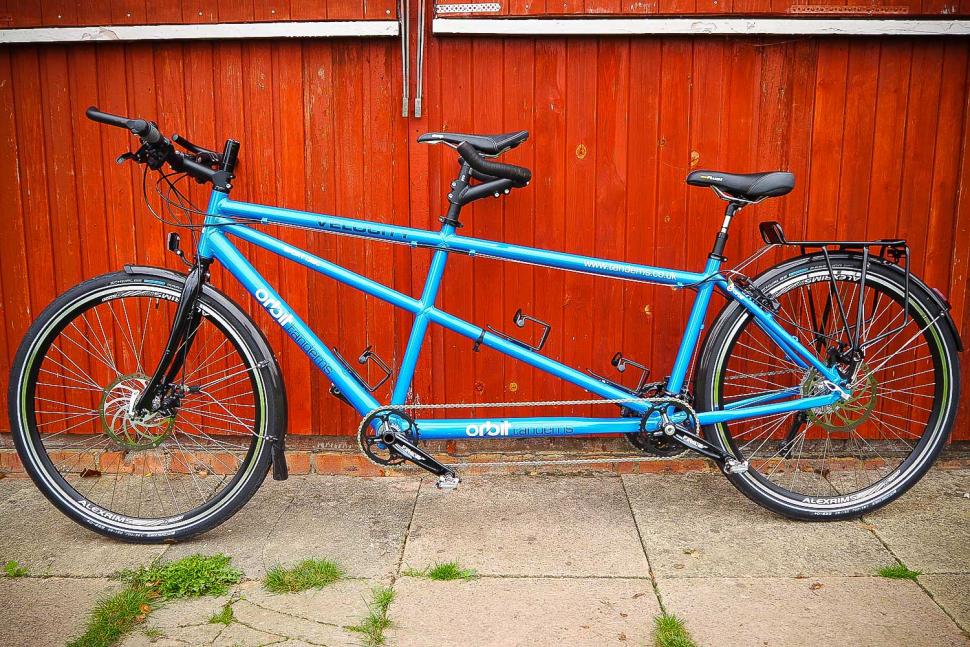

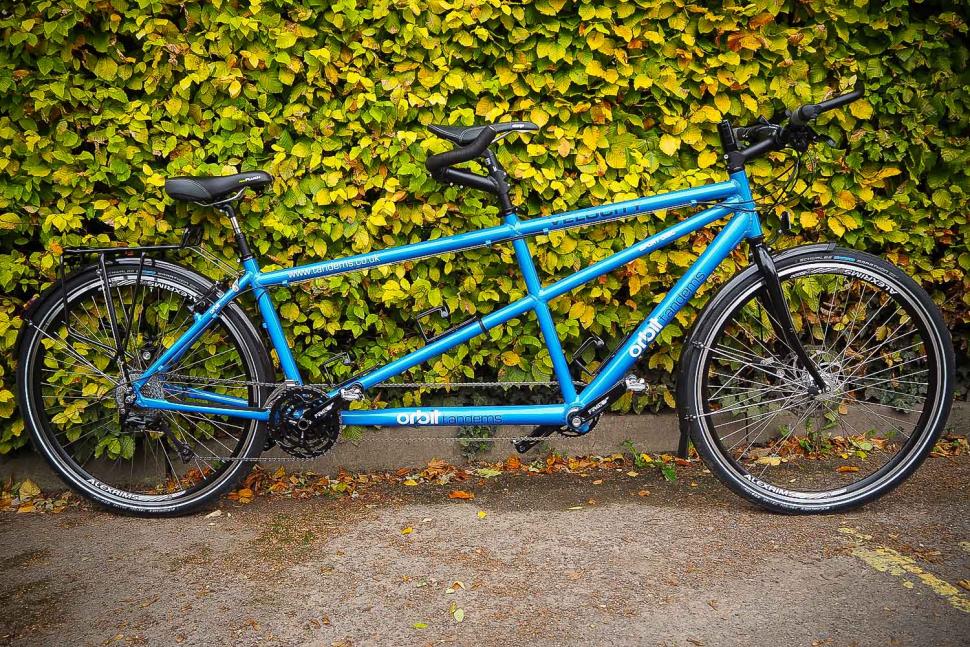
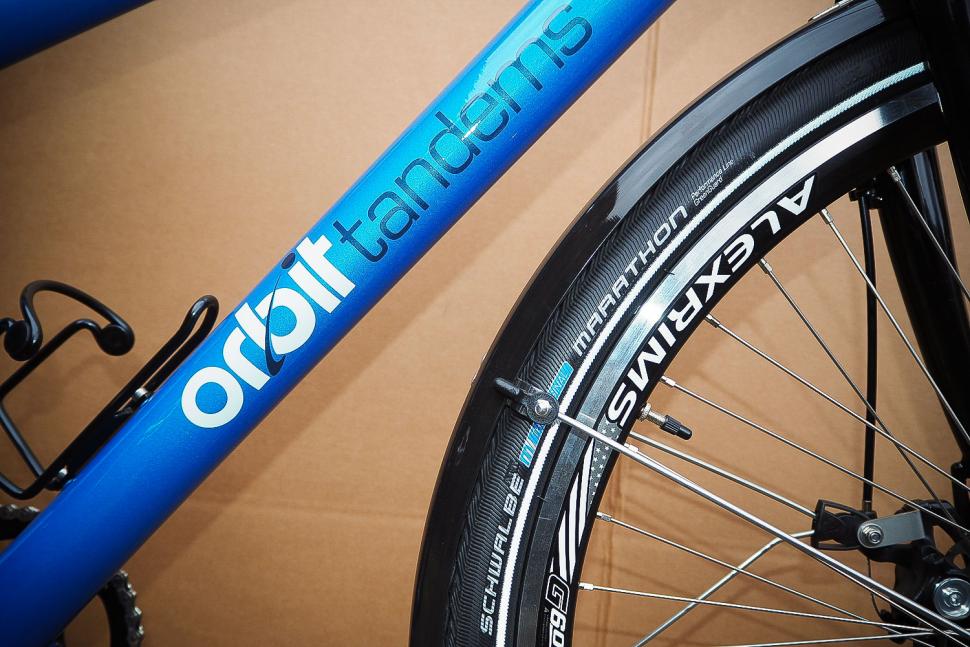
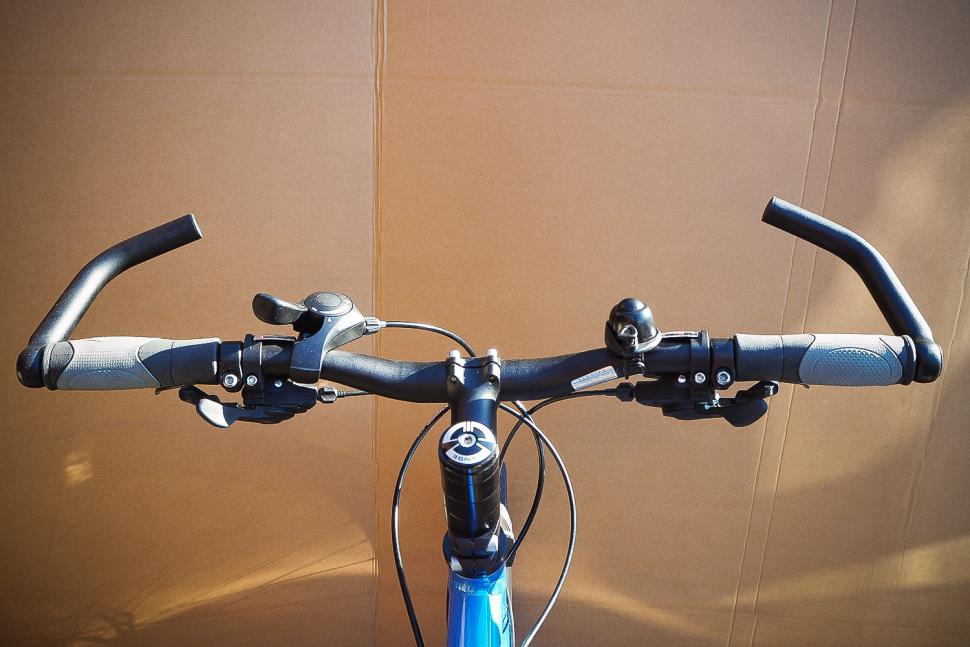
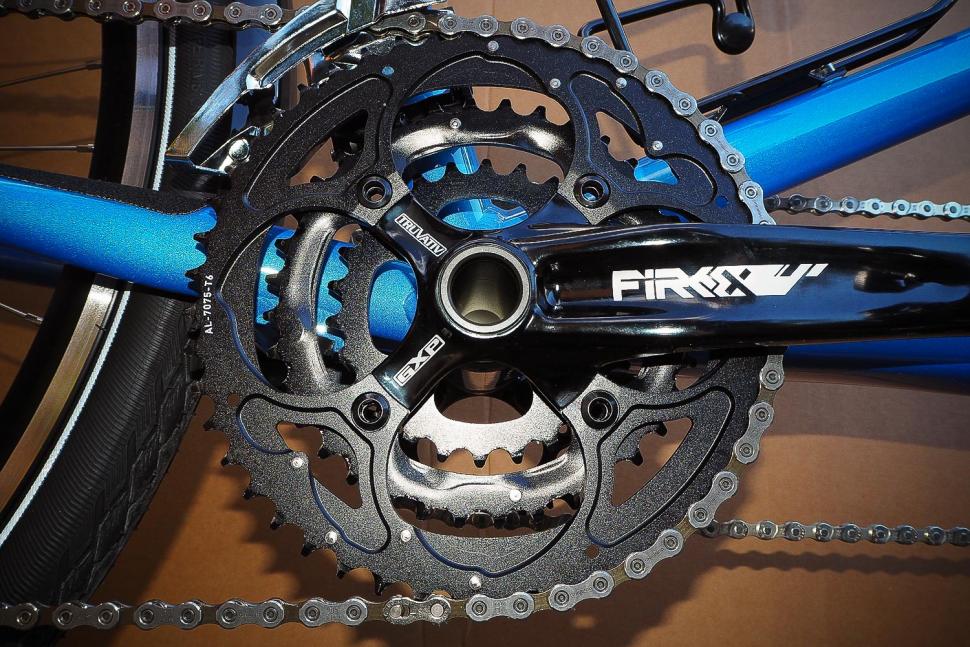
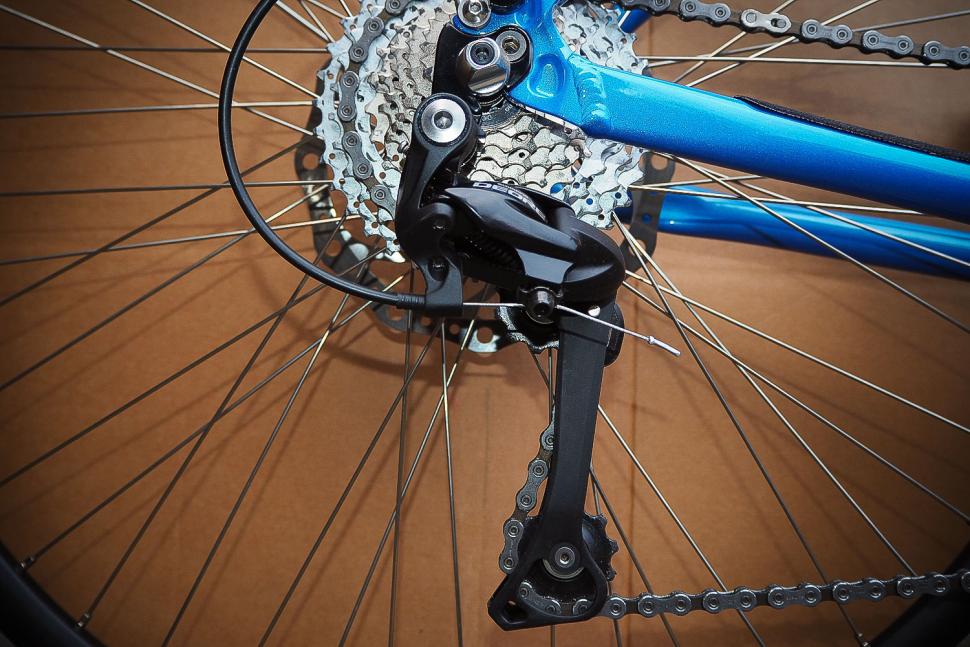
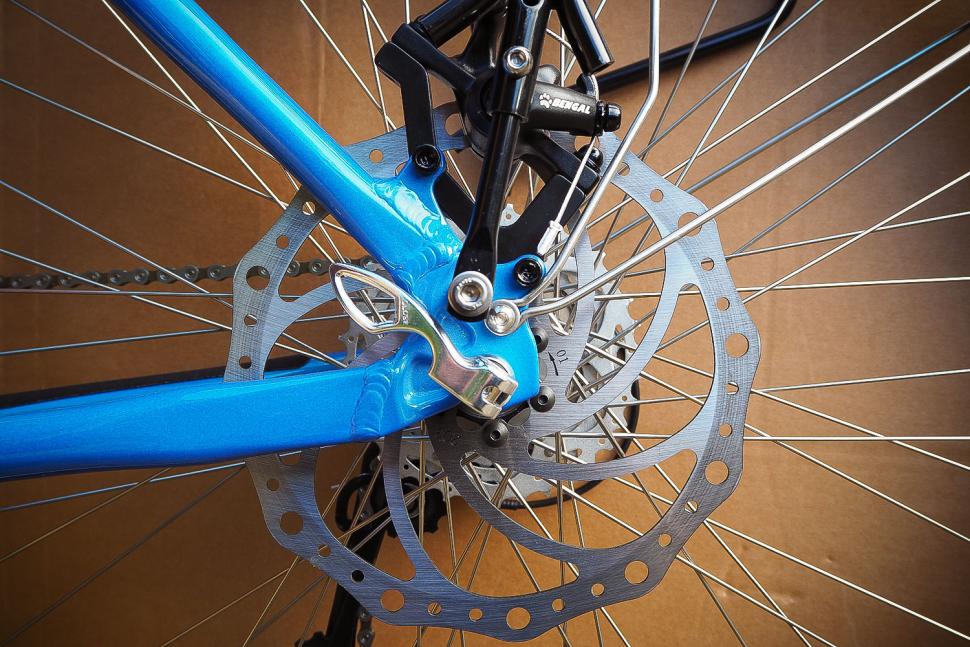

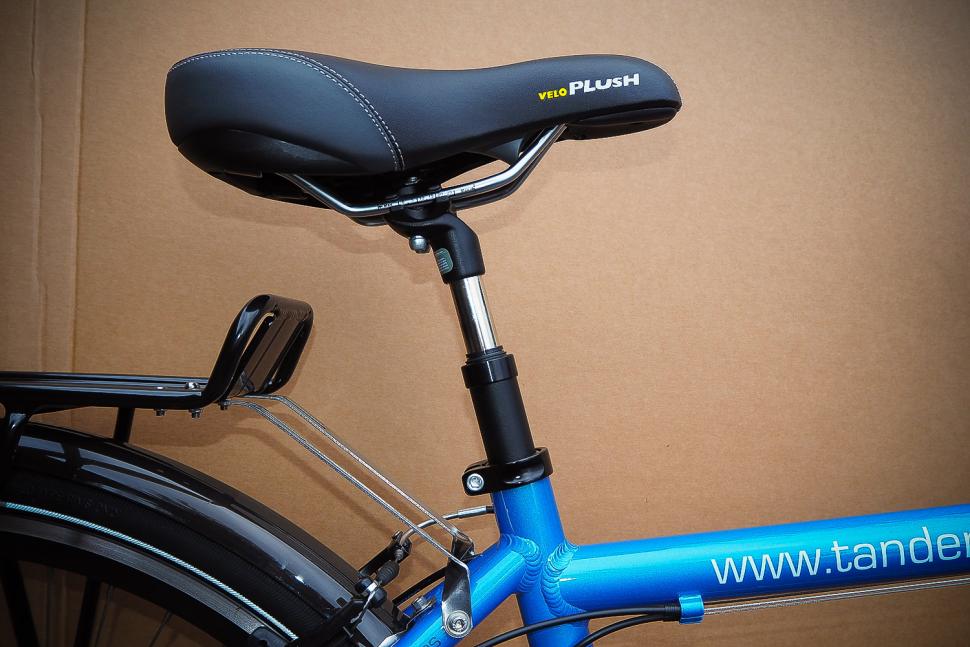

Add new comment
17 comments
iandusud,
It has been even longer since you posted your question, so I hope this response is still of some use.
I chose 26" wheels for our own machine, but that was over 10 years ago when the range of alternatives was much smaller. The attractions were that:
- a wider range of chunkier tyres were available than was the case for 700C (although that is less of an issue these days)
- the smaller diameter made for a stronger and better braced wheel, allowing me to be confident in using 36-spoke rims
- the smaller circumference gives a slightly lower gear for any given tooth combination, so it helped in achieving the lowest gear possible
If I were making the choice today then I probably wouldn't choose 26", simply because the choice of decent rims and tyres is only going to dwindle. On the basis that the advantages of a smaller wheel are still relevant, then I would see if I could get the sort of tyres and rims that I wanted in the 650B size - but if that were not possible then I would not have a problem in using 700C/29".
In summary, I would think carefully about committing to the 26" size unless you are confident in continued supply of your preferred components - and I would not have any worries about using the 700C size if it gives you all the features that you want.
Rich_cb: 50 mph is well short of our maximum speed on a tandem, but I thought it was acceptable for our first ride out on a new machine! Our aim is still to break 100 kph, but we keep falling a few kph short.
BehindTheBikesheds: like you, we use 50/39/24T on the front of our machine, but with 12-32T at the back, using an XTR RD-952 SGS; we even use 12-36T for special occasions, which is beyond the rated capacity – and does require the B-tension screw to be screwed fully in. So you are right, there is unlikely to be a problem with exceeding the rated capacity, but it is of course ‘at your own risk’.
iandusud: I ride both flat and drop bar solo bikes; the wife only uses flat bars. We chose flat bars on the Orbit for the same reason that we chose them on our Santana: they are more suited to the leisure riding that we do on the tandem, and when combined with bar-ends they give me 2 of the 3 major hand positions that drop bars offer. The missing drop position is not one I would use often anyway as the wife does not want to use drop bars, and whilst you can have different bar styles front and rear, it would be pointless for only one of us to be in a crouched aero position!
Richard, I know it's a while since you posted so I hope you see this. We have just picked up a S/H Orbit Velocity and are loving it. It has dropped bars at the front which suits me fine. It is fitted with 26" rims as this is an earlier Velocity model which has the option of of fitting 26" or 700c rims. This is achieved at the back by have two positions for the cantilever bosses. At the front this is achieved by using a size specific fork. I have replace the 28mm Gatorskins with 1.6" Schwalbe Marathon Supremes which, run at 60psi, roll along nicely. However I'd be interested to have your thoughts on the difference between 26" and 700c on a tandem. Sooner or later I'm going to need to replace the front rim as it wears and at that time I will probably change the fork to one that will take a disc brake, so that would be a good opportunity to convert to 700c if there was any advantage. We ride on road but wouldn't be averse to riding hard packed gravel tracks like those found in Derbyshire and elsewhere. We probably weigh around 150kg between us.
Thanks, Ian
Never mind the bike, kudos to the author and stoker for their synchronised commitment to standard Road.cc photo conventions of 'out of the saddle, right leg down, angle the camera so it looks like a hill'
So we could enter some tandem teams for Team Road.cc in the Revolve24 this year then.....I already have a potential
victimstoker and a Circe Helios tandem arranged for my entry.....Who was mad enough to agree to that? You keep threatening to do it, maybe we should make you put your money where your mouth is
Ian, we updated our Tandem to an Orbit in March. Delighted. They are really helpful, expert, and have a great selection to try. We wanted one to keep up on Club Rides, so ended up splashing out on the Titanium Tandem with lighter wheels/hubs etc. as well as the option of Ultegra Di2 with 11-42 cassette and a Wooftooth rear mech hanger to make that work. I think it comes out about 15.5Kg all in. It flies (on flats and downs anyway). We have drops at the front and bullhorns at the back which work well and, as you say, gives hand position options. The sprung post at the back is worth the extra weight. 3800miles since March with Century+'s. Managed Winnats Pass, so entered C2C in a day this year on it.
I would recommend arranging a daytrip with kit to chat and try out a few and see what suits your planned style of riding (and budget). It's got a good selection of roads round Gargrave to try them on.
Tandem riding: the quickest form of Marriage Guidance.
You can now enter as a tandem competitor in the CTT hill climbs, we had no entries in ours last year though.
I've been looking at Orbit tandems for a while with a view to trying one out with my wife. I'm interested in the fact that you chose an option using flat bars. Is this your set up on your Santana? Do you use flat bars on your solo bikes? I can see that a flat bar would give more control (I have extensive experiance of MTBing and road riding) but prefer drops for road riding as it allows me change position regularly on longer rides. Any tandem related experience would be greatly appreciated. Ian
We have two Orbit tandems, started off with a flat bar Summit and added a drop bar titanium last year. Both fabulous bikes, the titanium was well outside our budget but after our test ride we weren't going to have anything else.
As far as the bars go I do sometimes find the drops a little more tiring on long rides, but I suspect that's mainly because they are narrower and the bike is a bit more twitchy.
Something else to consider if you end up with a non electronic triple with drops is that if you're anything like me you may find it hard to keep track of where you are on the cassette as you can't just look down to check. I got over this problem by installing a little mirror at the top of the downtube.
Another big recommendation for JD Tandems from us, their customer service is brilliant and nothing is too much trouble.
The older M761 rear derailleur was rated at 45T but can handle 49T so it is quite possible to run 48/36/22 at the front and 11/34 at the back which would give a 19" or so bottom gear. However, on my solo for loaded touring I find it better to run 48/32/22.
Again, while this is not a review of the bike shop, I can attest to the excellent service from JD Tandems. And indeed the excellence of the Orbit tandem we have. The odd minor niggle here and there but over the nearly 5 years it's been going we have had little trouble with it. Which is good as we are a long way from Gargrave.
If you are looking for a tandem in the UK, then the Orbit range and JDs have to be on your radar.
road.cc's tandem of the year 2018/19 everbody!
I use a 50/39/24 +12-30 with a 10 speed 105 long cage for touring purposes (21.6") so I really don't see the problem with the Deore rear mech on a wider range than the std spec. I know the modern road rider has a tendency to ride big/big but on a tandem that's virtually unheard of so putting on a 22T ring to use with even a 50T shouldn't be an issue, not that I could see anyone wanting to jump to the 50T anyway as it makes next to zero difference in top end at the cost in other aspects.
Descending at 80kph on a tandem. Chapeau!
first time I broke 50mph was on the back of a tandem coming down Middleton Bank (North Yorks). I'm still clenching thinking about it...
Broke that on my tandem on a hill in a race - at one point, I thought we might have to overtake the car we were gaining on, but the road levelled out and he put his foot down a bit.